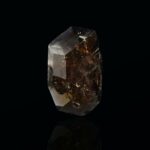This article delves into the captivating phenomenon of “shimmer with an array of colors,” a phrase that sparked curiosity in the New York Times Crossword puzzle of May 30, 2024. The answer, “opalescence,” opens a door to a world of shimmering light and vibrant hues, a world we’ll explore in detail, from the science behind the shimmer to its artistic and natural expressions.
Decoding “Shimmer”: What is Opalescence?
The NYT crossword clue “shimmer with an array of colors” led solvers to the fascinating world of opalescence. This phenomenon, named after the opal gemstone, describes a unique interplay of light and matter, a subtle, milky iridescence that seems to shift and dance with movement. It’s not as dramatic as the vibrant color shifts of iridescence seen in a peacock feather, but opalescence possesses a captivating ethereal quality all its own. [https://www.lolaapp.com/pond-scum-nyt]
Opalescence arises from the way light interacts with a material’s internal structure. Imagine light waves encountering a microscopic obstacle course within a substance, causing them to bend and scatter. This scattering, known as diffraction, creates the soft, milky glow we associate with opalescence. The particular hues and how they shift depend on the size and arrangement of these internal structures. Think of shining a flashlight through a foggy window—the light diffuses, creating a hazy glow. Opalescence operates similarly but at a microscopic level.
But opalescence isn’t limited to opals. It occurs in a variety of materials, both natural and synthetic. Moonstone, with its soft, bluish-white glow, owes its allure to opalescence. Certain types of glass and even some plastics can be engineered to exhibit this phenomenon. It appears in butterfly wings, adding a subtle sheen to their delicate beauty, and in certain beetle shells, sometimes combined with more vibrant iridescent hues. Even specialized pottery glazes are designed to mimic the opalescent look of opal. This widespread occurrence hints at nature’s remarkable ability to manipulate light and create stunning visual effects.
The Science of Shimmer: How Does Opalescence Work?
The shimmering effect described by “shimmer with an array of colors” boils down to how light interacts with the microscopic architecture of a material. In opals, this architecture is a marvel of natural engineering.
Opal’s Secret: A Symphony of Spheres
Imagine an opal as a city constructed of microscopic silica spheres arranged in a precise, grid-like pattern. When light enters this “city,” it interacts with these spheres and the spaces between them, creating an intricate three-dimensional diffraction grating. This grating scatters the light, creating the signature opal shimmer. The size of these spheres determines the colors we see. Smaller spheres diffract shorter wavelengths (blues and violets), while larger spheres diffract longer wavelengths (reds and oranges). It’s a microscopic orchestra, where the size and arrangement of the spheres dictate the final, shimmering symphony of color.
This internal structure distinguishes opals from many other gems that get their color from the absorption of certain light wavelengths by chemical impurities. In opals, it’s the architecture, the arrangement of the silica spheres, that creates the magic.
The Dynamic Dance of Light
The captivating shift and change of colors in an opal are a direct result of how light interacts with this internal structure. The angle of light entry affects the path length it travels through the silica spheres, changing the diffraction pattern and creating the mesmerizing dance of color. This dynamic play of light is key to opalescence, making it distinct from phenomena like fluorescence, which involves light absorption and re-emission.
Beyond Opals: Nature’s Palette of Shimmer
Opalescence extends beyond the world of gemstones, appearing across the natural world due to similar microstructures. Butterfly wings, beetle shells, some types of clouds, and even certain quetzal whistle feathers– all exhibit opalescence. In each case, microscopic structures within the material diffract light, creating shimmering iridescent or opalescent colors. From the vibrant hues of a butterfly to the soft sheen of a feather, the same fundamental principle is at play.
Finding the Shimmer: Opalescence in Nature and Art
“Shimmer with an array of colors” isn’t just a crossword clue; it’s a description of a phenomenon woven into the fabric of nature and embraced by artists throughout history.
Nature’s Opalescent Wonders
Nature provides a diverse array of opalescent displays. Fire opals glow with warm, vibrant hues, precious opals flash a kaleidoscope of colors, and moonstones offer a soft, ethereal blue sheen. But opalescence goes beyond gemstones. Morpho butterflies showcase shimmering blue wings, peacock feathers possess a subtle, opalescent sheen, and even some beetle shells exhibit this captivating quality. Surprisingly, even some liquids display opalescence under specific conditions, such as near their boiling point (critical opalescence), demonstrating the phenomenon’s reach beyond solids.
Opalescence in Human Hands
Inspired by nature, artists have captured and recreated opalescence in their work. Opal jewelry has adorned humans for centuries, showcasing the stone’s radiant play of color. Opalescent glass, infused with light-scattering particles, finds its place in stunning stained glass windows, delicate blown glass sculptures, and intricate mosaics, giving them a soft, pearly glow. Painters, too, have experimented with iridescent pigments and specialized techniques to capture opalescence on canvas.
The Allure of the Shimmer
The enduring fascination with shimmer likely stems from its dynamic nature, its constant interplay of light and movement. Perhaps it’s a connection to the complex physics turning ordinary materials into something extraordinary, or maybe it’s simply the inherent beauty, the way it captures and reflects light like a miniature universe. Whatever the reason, “shimmer with an array of colors” invites us to appreciate the science and artistry within the play of light.
Ongoing Research and Future Directions
While the fundamental principles of opalescence are understood, the precise relationship between microstructure and optical effects is an ongoing area of study. Scientists are exploring how different arrangements of nanoscale structures can influence the intensity and range of colors produced. This research could lead to innovative applications in materials science, photonics, and beyond, potentially resulting in more vibrant displays or even “smart” materials that change color in response to stimuli. The exploration of opalescence highlights how even seemingly simple phenomena can hold deep scientific mysteries.
From the solution to a crossword clue to the ongoing scientific exploration, the phrase “shimmer with an array of colors” has opened a window into the fascinating world of opalescence. It’s a reminder of the beauty and complexity hidden within the seemingly mundane, an invitation to appreciate the wonder of light and its interaction with the world around us. It’s also a reminder of the microscopic world, even something as seemingly simple as pond scum nyt, can hold surprising beauty and complexity.












